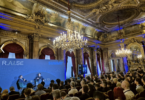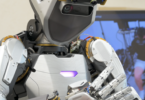Researchers at the University of Florida used a readily available and affordable technology to see how much information they could glean from human DNA gathered from the environment in a variety of circumstances, such as from outdoor waterways and the air inside a building.The results of their research, published Monday in the journal Nature Ecology & Evolution, demonstrate that scientists can recover medical and ancestry information from minute fragments of human DNA lingering in the environment.
It may, in fact, be almost impossible to avoid leaving DNA in public. David Duffy, a wildlife geneticist and his University of Florida colleagues found that they could successfully collect airborne human DNA even from people wearing gloves and surgical masks and gowns.
Forensic ethicists and legal scholars told the New York Times the Florida team’s findings increase the urgency for comprehensive genetic privacy regulations. For researchers, it also highlights an imbalance in rules around such techniques in the United States — that it’s easier for law enforcement officials to deploy a half-baked new technology than it is for scientific researchers to get approval for studies to confirm that the system even works.
As a proof of concept in one of their experiments, the researchers scooped up a soda-can-size sample of water from a creek in St. Augustine, Fla. They then fed the genetic material from the sample through a nanopore sequencer, which allows researchers to read longer stretches of DNA. The one they used cost about $1000. From the samples, the team recovered much more legible human DNA than they had anticipated. And as knowledge expands about human genetics, analysis of even limited samples can reveal a wealth of information.
The researchers recovered enough mitochondrial DNA — passed directly from mother to child for thousands of generations — to generate a snapshot of the genetic ancestry of the population around the creek, , noted the New York Times article. One mitochondrial sample was even complete enough to meet the requirements for the federal missing persons database.
They also found key mutations shown to carry a higher risk of diabetes, cardiac issues or several eye diseases. According to their data, someone whose genetic material turned up in the sample had a mutation that could lead to a rare disease that causes progressive neurological impairment and is often fatal. The illness is hereditary and may not emerge until a patient’s 40s. Duffy told the Times he couldn’t help but wonder — does that person know? Does the person’s family? Does the person’s insurance company?
There’s a wide market for genetic information — from pharmaceutical companies developing therapeutics, to insurance actuaries, to public health researchers. But protections for the public are stymied by the lack of workable legal definitions of what DNA actually is, Erin Murphy, a law professor at the New York University School of Law who specializes in the use of new technologies in the criminal legal system, said in an interview with The New York Times. Is it personal property? Is it data? Is it always medical information? Who owns it once it has been collected?
Bioethicists and civil liberties experts say that the University of Florida team’s warning provides decision makers a rare chance to discuss the ethics and the legality of a new genetic technique before it enters widespread use.
IN OTHER NEWS THIS WEEK
ARTIFICIAL INTELLIGENCE
G7 And AI Leaders Call For Guardrails Around The Technology
G7 leaders are calling for the formulation of “guardrails” around the development of artificial intelligence, at a summit of the grouping that is tackling the emerging technology for the first time, reports the Financial Times.
The call comes just days after Sam Altman, chief executive of ChatGPT creator OpenAI called on Congress to create licensing and safety standards for advanced artificial-intelligence systems, as lawmakers begin a bipartisan push toward regulating the powerful new tools available to consumers.
“We understand that people are anxious about how it can change the way we live. We are, too,” Sam Altman said of AI technology at a Senate subcommittee hearing Tuesday, his first appearance before Congress, reported the Wall Street Journal. “If this technology goes wrong, it can go quite wrong.” Altman called for “a new agency that licenses any effort above a certain scale of capabilities and could take that license away and ensure compliance with safety standards.”
EU lawmakers last week agreed on a tough set of rules over the use of AI, including restrictions on chatbots such as ChatGPT.
The New York Times this week published a story about how as a race to lead A.I. heats up across Silicon Valley, Meta is standing out from its rivals by taking a different approach to the technology. Driven by its founder and chief executive, Mark Zuckerberg, Meta believes that the smartest thing to do is share its underlying A.I. engines as a way to spread its influence and ultimately move faster toward the future.
Its actions contrast with those of Google and OpenAI, the two companies leading the new A.I. arms race. Worried that A.I. tools like chatbots will be used to spread disinformation, hate speech and other toxic content, those companies are becoming increasingly secretive about the methods and software that underpin their A.I. products.
Google, OpenAI and others have been critical of Meta, saying an unfettered open-source approach is dangerous. A.I.’s rapid rise in recent months has raised alarm bells about the technology’s risks. “We want to think more carefully about giving away details or open sourcing code” of A.I. technology, said Zoubin Ghahramani, a Google vice president of research who helps oversee A.I. work told the New York Times. “Where can that lead to misuse?”
Meanwhile Nikkei Asia reported that Baidu’s CEO told analysts on May 16 that the company would make sure its ChatGPT competitor doesn’t “hallucinate” on “sensitive” topics. China’s regulators have proposed rules on generative A.I. that demand that models go through a security review and promote “socialist core values”—which may be a problem for A.I. models known for making up details
(For more context see The Innovator’s Interview Of The Week with AI Ethics Expert Kellee Tsai)
TECH FOR GOOD
AI To The Rescue?
Tech To The Rescue, the world’s largest community of tech companies that engage in pro-bono projects for the greater good, is aiming to discover how the future of AI can benefit society by organizing the world’s first and largest Generative AI for Good Hackathon, which is an intensive programming and creative thinking marathon, from June 14th – 15..
QUANTUM COMPUTING
U.S. Japan Quantum Computing Push As China Looms
IBM and Google are giving $150 million for quantum-computing research at the University of Chicago and the University of Tokyo as the U.S. and Japan try to stay ahead of a fast-rising China. Quantum computers are a hot area of research because they could help solve problems that classical computers alone can’t, such as modeling how a drug molecule interacts with the body’s proteins or how batteries work at an atomic sca
EUROPE
UnternehmerTUM Leads New European Initiative To Promote Startups
Leading ecosystem builders from 14 European countries are teaming up to empower the next generation of game-changing and transformative startups to secure long-term prosperity in Europe. The ambition is to match the innovativeness of countries like USA and China by helping European start-ups to scale and become global market leaders. Twenty ecosystem builders from leading universities and start-up hubs accepted the invitation of UnternehmerTUM – the center for innovation and business creation at Technical University of Munich – to attend the first Rise Europe summit in the Bavarian Alps last week.(The Innovator is UnternehmerTUM’s international media partner.) Rise Europe is a collaboration of leaders from: Aalto University, Agoranov, Beta-i, Campus Founders, DLD, DTU Skylab, École Polytechnique, ETH AI CENTER, ETH Zurich, HighTechXL, IE University, Imperial College London, INiTS, KTH Innovation, EnSpire Oxford at Oxford University, Sting, TalTech, Tangent at Trinity College Dublin, UnternehmerTUM and Vento.
To access more of The Innovator’s News In Context articles click here.







